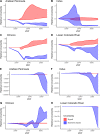Evaluating the economic impact of water scarcity in a changing world
- PMID: 33772023
- PMCID: PMC7997906
- DOI: 10.1038/s41467-021-22194-0
Evaluating the economic impact of water scarcity in a changing world
Abstract
Water scarcity is dynamic and complex, emerging from the combined influences of climate change, basin-level water resources, and managed systems' adaptive capacities. Beyond geophysical stressors and responses, it is critical to also consider how multi-sector, multi-scale economic teleconnections mitigate or exacerbate water shortages. Here, we contribute a global-to-basin-scale exploratory analysis of potential water scarcity impacts by linking a global human-Earth system model, a global hydrologic model, and a metric for the loss of economic surplus due to resource shortages. We find that, dependent on scenario assumptions, major hydrologic basins can experience strongly positive or strongly negative economic impacts due to global trade dynamics and market adaptations to regional scarcity. In many cases, market adaptation profoundly magnifies economic uncertainty relative to hydrologic uncertainty. Our analysis finds that impactful scenarios are often combinations of standard scenarios, showcasing that planners cannot presume drivers of uncertainty in complex adaptive systems.
Conflict of interest statement
The authors declare no competing interests.
Figures



References
-
- Forum, W. E. Global Risks 2015. 69 http://www3.weforum.org/docs/WEF_Global_Risks_2015_Report15.pdf (2015).
-
- Nations, U. Sustainable Development Goals: 17 Goals to Transform Our World. https://www.un.org/sustainabledevelopment/ (2015).
-
- Gleick, P. The World’s Water, Vol. 7, The Biennial Report on Freshwater Resources. SERBIULA Sist. Libr.20, 10.5822/978-1-61091-483-3 (2011).
Publication types
LinkOut - more resources
Full Text Sources
Other Literature Sources

